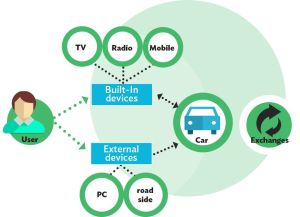Connected cars leave all-new tread tracks for marketers

Picture credit: iStockphoto
The idea of the digital supercomputer car has been around since the 80’s. Characters like Knight Rider’s K.I.T.T had the ability to learn, communicate and even connect with Michael Knight on some emotional level, not bad for a Pontiac Trans Am.
While in the 80’s it seemed that the reality of an intelligent car was only for the magic of television, today we not only have intelligent cars, but are heading towards a future where your car can be your personal assistant, delivering you custom information and anticipating your needs even before you do.
Data is the key to personalising information. The connected car creates a number of interesting data points and is able to determine everything from your favorite nearby restaurants to how often you speed. Two types of data make this possible: static data and dynamic.
Static data
Static data is just that, fixed, data that will not change and/or progress; for example, car make and model, ownership and user details (e.g. demographic data). While dynamic data is the opposite, this is data that changes constantly; for example, location, general usage and usage patterns (driving style, accidents), and this is where the real magic lies.
Gartner has predicted that by 2020 there will be nearly 26 billion devices connected. With an average of three connected devices per person, so it is no surprise that your car will just be another piece to this connected world.
As part of the advent of the Internet of Things (IoT), your car is connected to the online world, while devices can connect to your car and help predict your needs while driving. For example, let us say you are on a road trip and you have a specific destination in your navigation, but you find yourself low on gas; just in time the navigation reroutes you to the nearest preferred gas station that has the gas type needed for your car at the best price.
Dynamic data
 The market opportunities do not end there however, with cross-device targeting, advertisers will even be able to display custom roadside ads either via built in navigations screen of the car or a mobile device. We are not far from a future where a dynamic out of home display will be able to display an ad for car parts for a specific car model that is driving past. To the right is a breakdown of the connected car landscape.
The market opportunities do not end there however, with cross-device targeting, advertisers will even be able to display custom roadside ads either via built in navigations screen of the car or a mobile device. We are not far from a future where a dynamic out of home display will be able to display an ad for car parts for a specific car model that is driving past. To the right is a breakdown of the connected car landscape.
The user is connected to the car twofold via built in devices: TV, radio, mobile and by external devices: computers and roadside signs and locations. All of this information is then processed and made actionable via ad exchanges.
The catalyst of this personalised, real-time content delivery will be programmatic marketing. Programmatic marketing presents the best possibility to segment and activate the heaps of data that the connected car will provide.
Programmatic marketing
All of the data points collected from the driver from various devices (the car, built-in devices and external devices) is fed into a programmatic-marketing platform, and that data is then activated into advertising displayed to the driver when he/she is most likely to respond to the bespoke offer.
While the connected car presents a bevy of marketing opportunities, there remains a number of questions that will need to be answered. The biggest of which is who will own various data points and how it will play into the consumer privacy concerns.
Another uncertainty will be tracking. Again privacy issues will be at the forefront of the discussion as well as the advances of ad tech. Cross-device tracking is a hot topic in the ad world and how this technology develops will have a significant impact on future in-car campaigns. This is important to ensure the right message is sent to the right user in order to drive conversions. For instance, using a mobile wallet, frictionless payments could be made upon going to a drive-thru or filling up your tank.
Although there will be a few hurdles to overcome (as is the case with any new technology), the connected car represents a wealth of opportunities for marketers. What was once the thing of advertisers’ dreams is very quickly becoming reality.
Research conducted by Anna Ahtiainen, Director, Client-Side Data Science and Anja Lorbeer, Head of Market & Process Development

Leave a comment
Alternatively
This will only be used to quickly provide signup information and will not allow us to post to your account or appear on your timeline.
20 Mar 2015, 2:54 p.m.
Excellent post! It’s been quite helpful. Thank you so much for sharing your knowledge. I am looking forward to reading your future updates.
Reply